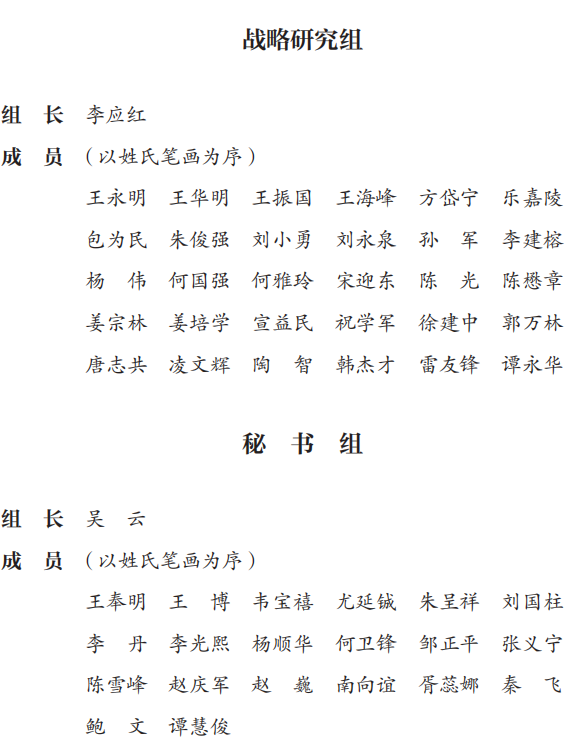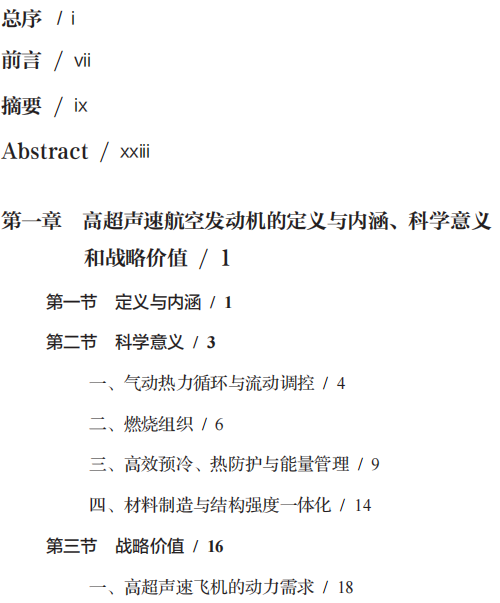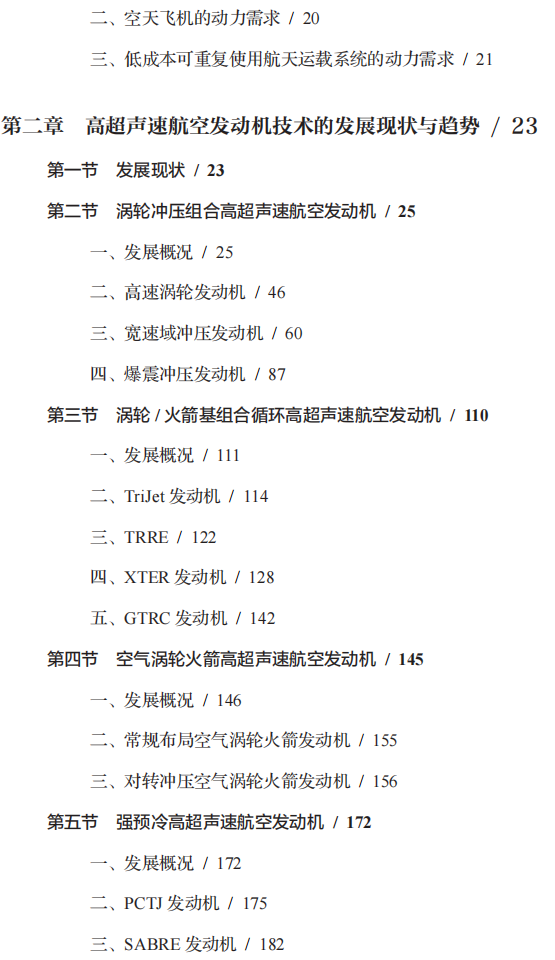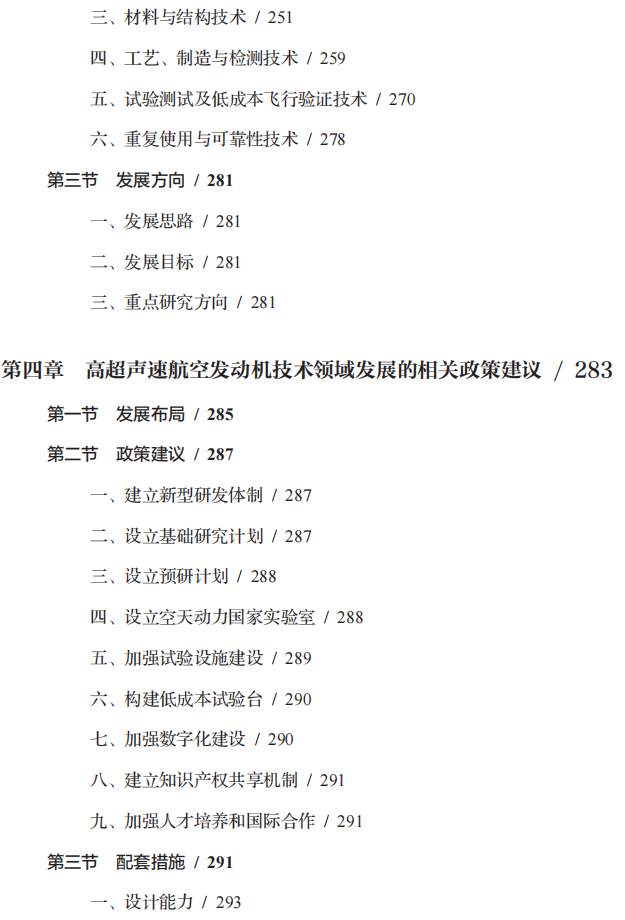一、本领域的基本内涵、科学意义与战略价值
(一)基本内涵
作为高超声速飞机的动力装置,高超声速航空发动机具有多项核心能力:一是能支持高超声速飞机实现水平起降;二是飞行包线更广,升限大于25 km,最大飞行马赫数不低于5;三是寿命长,能长时间重复使用。
常规的涡轮发动机和冲压发动机的飞行马赫数范围有限,涡轮发动机的飞行马赫数一般是0~2.5,冲压发动机的起动马赫数一般大于3。为实现高超声速航空发动机从零速到高超声速吸气式推进的技术需求,需要将传统动力(如涡轮发动机、冲压发动机和火箭发动机等)进行有机融合。增材制造、轻质高温材料、强预冷、等离子体调控、对转冲压、爆震燃烧等新兴技术成熟度的提高,有望进一步提升高超声速航空发动机的性能。
(二)科学意义
作为航空发动机领域的技术制高点和国际热点,高超声速航空发动机是一个极其复杂的系统,具体涉及材料、制造与强度、热力、气动、燃烧、控制、传热等多个学科,需要突破极端热、宽空域、宽速域、重复使用等技术难点。
开展高超声速航空发动机基础研究,具有重要的科学意义。一是可以揭示航空发动机设计和制造领域涉及的机理,如宽工作速域、长寿命使用、高推力重量比、高比冲约束条件下的热力循环、流动燃烧组织、热质传递、轻质高温材料、制造形性调控、结构损伤演化、一体化控制等;二是催生交叉学科的新方向,如极端条件下流—热—固—化耦合能质传递学、复杂超高温结构力—热—声—氧耦合失效学等;三是推动研究范式的变革,从传统航空发动机先性能设计后强度评估的弱耦合、解耦研究范式,上升到高超声速航空发动机极端条件下的多物理场强耦合研究范式。
(三)战略价值
航空发动机是工业皇冠上的“明珠”,高超声速航空发动机更是“明珠”中的极品,对高超声速飞机的研发具有决定性作用,是一个国家综合国力的体现。另外,作为一种吸气式动力装置,高超声速航空发动机可以作为空天飞机、可重复使用航天运载系统等的一级动力支撑其发展。
世界各国和地区都在抓紧研究高超声速航空发动机,并为此投入了大量的人力、物力和财力,旨在抢占技术制高点,形成巨大的技术不对称优势,但是一直久攻不克,研发进度难以匹配预期。可以预见的是,一旦高超声速航空发动机技术取得突破,将会催生多个领域的重大变革,如空天装备和民用航空。
由于研究起步较晚、投入力度不足、技术积累较弱、技术力量相对分散,我国在高超声速航空发动机技术领域与国际先进水平存在较大差距。为迎头赶上国际先进水平,支撑世界科技强国和航空航天强国建设,需要在系统梳理现状、统筹规划发展等方面下足功夫。
二、本领域的研究特点、发展规律和发展趋势
(一)研究特点
一是多目标约束,使得技术难度非常大。既要在宽广的飞行包线内提供稳定强劲推力,并能长期可靠工作,又要满足多次重复使用的要求,还要实现较大的推力重量比。
二是多学科/多系统耦合,试验和数值仿真难度都很大,从系统工程的角度研究透彻十分困难。高超声速航空发动机不仅涉及材料、结构、强度与极端气动热力等学科之间的紧密耦合,还存在发动机内部不同系统及发动机与飞行器的紧密耦合。
三是多技术路线,目前由于技术路线不明晰,尚未收敛,多条技术路线正在齐头并进。
(二)发展规律
1.技术难度超出预期,组合方案曲折前进
与传统的航空涡轮发动机21世纪初取得技术突破的高超声速超燃冲压发动机相比,高超声速航空发动机的工作速域拓宽了一倍以上。飞行马赫数每增加1,发动机的研发难度和周期都将大幅增加。涡轮机组合动力是目前高超声速航空发动机发展的主要技术途径,但是仍然存在较多的技术难题。涡轮冲压组合发动机面临模态转换“推力鸿沟”等重大技术障碍。火箭增推和射流预冷等技术虽然能有效解决“推力鸿沟”问题,但是存在热防护困难、比冲低、结构复杂等难题。在高速涡轮发动机、超燃冲压发动机技术快速进步的背景下,美国加大了涡轮冲压组合高超声速航空发动机的研发力度,加快推进了技术成熟和工程发展,但依然面临很大的难度。
1966年服役的美国SR-71“黑鸟”(Blackbird)侦察机最大飞行速度为3.2倍声速,并且由于载荷小、效能差,已经退出现役;预计2030年左右服役的SR-72“黑鸟”之子,最大飞行速度为6倍声速,从公开资料来看,发动机依然面临很大的技术不确定性。由于高超声速航空发动机的研发难度和进度大大超出预期,所以很多相关的重大研究计划被迫终止。每个国家在涡轮发动机、火箭发动机、冲压发动机、预冷技术等方面的研发基础不一样,因此其选择的技术路线和主攻方向也有明显差异。
2.新兴技术不断涌现,新的材料工艺助推发展
鉴于强预冷技术对高温来流的冷却作用,英国对其进行了大量的设计和试验探索,并且得到了英国政府、欧洲空间局(European Space Agency,ESA)、美国空军研究实验室(Air Force Research Laboratory,AFRL)、美国国防部高级研究计划局(Defense Advanced Research Projects Agency,DARPA)等机构的研发经费支持,以及英国航空航天系统公司(British Aerospace Systems,BAE)、罗尔斯—罗伊斯(Rolls-Royce)公司(以下简称罗罗公司)、波音(Boeing)公司等的资金和技术支持。研究结果初步展现了强预冷高超声速航空发动机推力重量比高、比冲高的性能优势。我国科学家提出了对转冲压压气机的原创性方案,利用转子相对旋转制造了超声速气流,建立低熵增激波系统实现了高效增压与高通流,大幅减少了压缩系统的尺寸和重量,并拓宽了压气机流量适应性,颠覆了传统轴流压气机气流折转的增压原理,有望显著提升高超声速航空发动机的推进效能。爆震燃烧采用近似等容燃烧代替原有布雷顿循环(Brayton cycle)中的等压燃烧,循环方式的改变有望显著提升高超声速航空发动机的推进效能。等离子体点火助燃通过高能量强穿透大火核、油气活化和流场调控,有望显著拓宽冲压发动机的工作速域并提升其性能。智能增材制造具备设计、制造、性能一体化,加速设计迭代,多尺度轻质化结构减重等优点,是我国高超声速航空发动机发展的机遇和快车道。轻质高温材料是高超声速航空发动机的主要结构材料,对提高其推力重量比,确保宽温域、高速重载等极端条件下的服役安全至关重要。
3.科学技术难题交织,基础研究必须先行
基础科学问题制约着技术瓶颈的突破。例如,一体化热力循环和轻质高强材料结构制造一体化是提高推力重量比的重要源头;低动压、低总温条件下的高效燃烧组织机理与方法是拓宽冲压发动机下限马赫数的重要源头;宽速域高通流叶轮机械内流组织机理与方法、耐高温机械系统设计方法是拓宽涡轮发动机工作速域的重要源头。必须花大力气推进基础研究,只有在对基础问题系统深入认识的前提下,才能追求高的技术指标和研发速度。
(三)发展趋势
不同形式发动机的简单叠加、分段使用会引发加速能力弱、燃油经济性差、推力连续性差、阻力大和“死重”大的问题,必然无法成为主流方案。新颖热力循环与单项变革技术融合发展才是高超声速航空发动机技术的必由之路。为推动一体化宽域高效气动热力循环的发展,深入揭示各系统间的热功转化及参数耦合机制,必须从新概念、新工质、新材料等方面入手。爆震燃烧、对转冲压、等离子体调控、强预冷分别是提高热力循环效率、提升叶轮机械通流能力、拓宽冲压发动机工作速域、拓宽涡轮发动机工作速域的关键性技术,虽然取得了显著进展,但是仍需要大力发展。在新颖热力循环的牵引下,适度超前发展轻质高强材料与结构的设计和制造,有望提高高超声速航空发动机的推力重量比和寿命。
三、本领域的关键科学问题、关键技术问题、发展思路、发展目标和重要研究方向
(一)关键科学问题
高超声速航空发动机技术的关键科学问题是:宽飞行包线、高可靠性和长寿命使用、高推力重量比约束条件下的燃烧流动组织、传热传质、热力学循环、轻质高温材料、制造形性调控、结构损伤演化、一体化控制机理。
在高超声速航空发动机热力循环、气动燃烧与控制机理方面,包括宽域高效耦合热功转换理论,以涡轮发动机、冲压发动机、火箭发动机为基本动力单元的新型热力循环构建方法,基于新型热力循环的高效热功转换机制;子系统级工作速域及推力拓展机制,子系统间的流量/压力匹配及速域/推力补偿模式与机理,多维度架构与综合性能寻优、双乘波飞机—发动机一体化、宽域高性能可调节进排气设计等气动优化理论;基于高效预冷的多工质强非线性热力系统能量耦合机理;低熵增进气道/叶轮机械耦合增压理论,熵产极小化激波增压理论与优化设计方法,常规及特殊工质叶轮机械新气动布局宽域做功原理,宽域高效叶轮机械设计与流场调控方法;宽速域高效燃烧组织机理与调控方法,宽适应性多模态燃烧组织方法,等离子体点火助燃机理与方法;高超声速航空发动机失稳判据及增稳理论,复杂流场智能感知与监测方法,子系统控制规律及全包线高精度鲁棒控制机制,发动机/飞行器协同控制机理与高效鲁棒协调控制方法等。
在高超声速航空发动机高效预冷、热防护与能量管理机理方面,包括极端热与复杂条件下的多尺度流动换热耦合理论,紧凑空间环境中大温差、强变物性、多尺度等条件下流动与换热的耦合机理及时空演化规律;超高温、大热流、强激波等条件下强变物性流体热质传递机理;高热流紧凑结构下强预冷快速高效传热机理,高效预冷与紧凑轻质预冷器设计方法;强耦合、非线性、高动态特征下多系统热/质交互作用机理与热惯量匹配机制,复杂热环境耦合传热传质机理及强扰动条件下的热防护调控机理和规律;先进热防护方法与耦合传热规律;超燃冲压发动机单独工作时的能源生成方法;多场耦合条件下高热流有限冷源热防护、热管理一体化机理与精细化热结构设计方法,整机热量产生、收集传输、储存利用和排散的耦合机制,先进能量管理方法与系统动态调控方法,整机热/质实施优化分配和动态管理方法。
在高超声速航空发动机材料制造与结构强度一体化机理方面,包括轻质高强耐热复杂结构的设计与制造一体化理论,面向极端环境的多场多相多介质结构强度理论,材料/结构的损伤和失效模式及机理、多场多相多介质耦合力学模型;轻质耐热材料与复杂结构的一体化设计,典型结构的材料—结构—功能一体化设计与制造方法,多相合金材料小微尺度热动力学耦合机理及宏微观性能关联,难加工材料高温复杂冷却结构制造方法;基于增材制造微小熔池高温度强对流极端冶金条件和高温度梯度非平衡快速凝固条件的新型高性能合金设计与强韧化方法;基于多场多相多介质和面向极端环境的强度设计理论及方法,极端宽温域材料环境下材料制造一体化设计与制备方法,复杂高效冷却结构、结构拓扑先进制造方法。
(二)关键技术问题
高超声速航空发动机研制的关键技术问题是:如何将宽飞行包线高效热力循环映射成长寿命、高推力重量比的发动机。这不但涉及多个技术行业,如气动热力设计、预冷、热防护、材料、制造、试验等,还与强预冷高超声速航空发动机、空气涡轮火箭发动机、涡轮/火箭基组合循环发动机、涡轮冲压组合发动机等多种组合动力有关。总体来看,高超声速航空发动机研制是一个复杂的系统工程。
在热力循环设计分析与流动燃烧调控方面,包括飞机—发动机一体化、热力循环及部件匹配设计、极宽适应性流动控制与先进调节、宽范围多模态燃烧组织、等离子体点火助燃、模态转换策略及控制、燃油供给系统设计和控制、能量综合管理及系统优化、智能化控制诊断、高保真度数值模拟等技术。
在预冷与热防护方面,包括轻质高效高温预冷器、高功重比微通道换热、受限空间极端高热流高效冷却、超高热沉低结焦再生冷却、新型复合热防护、热结构传热快速评估、超低环境压力下高效换热等技术。
在材料与结构方面,包括多组元杂化耐极高温复合材料、超高温复合材料环境热障涂层、新型陶瓷基复合材料、高温高强韧钛基复合材料、超高温抗氧化难熔金属基复合材料、新型低密度耐更高温合金材料、耐高温隔热涂层材料、单相化多组元高性能热障涂层、超紧凑高温高效复合隔热材料、预冷换热器用抗氢脆高温合金、结构轻质化设计、先进润滑与密封材料、超高温可调结构密封元件、高温高压氦叶轮机动密封、高速高温轴承润滑脂、高热沉高能量燃料、氢燃料、绿色氧化剂等技术。
在工艺、制造与检测方面,包括陶瓷基复合材料结构件加工与连接、难变形材料薄壁复杂构件超塑成形、微小孔加工、精密电解加工工艺、难加工金属材料高速电弧加工、轻质高效预冷器制造工艺、复杂薄壁异形构件激光焊接工艺及质量控制、异种金属过渡接头微扩散连接、超大尺度异种材料增材制造、梯度复合材料增减材复合制造、一体化结构设计与增材制造、热防护涂层制备、大型关键薄壁零件变形控制及自适应制造、智能装配与精密检测等技术。
在试验测试与低成本飞行验证方面,包括大流量高焓燃烧加热、高焓纯净空气加热、大尺度发动机试验、变马赫数自由射流试验、变马赫数直连试验、模态转换试验、姿态瞬变多样流耦合宽域环境模拟、高温高压高速环境小扰动高精度试验测试、氦循环系统试验、低成本高超声速飞行验证等技术。
在重复使用与可靠性方面,包括可重复使用设计、高效轻质换热器结构可靠性评价及试验验证、陶瓷基复合材料高温环境性能预测与测试、非均质焊接接头高温力学响应及结构服役性能提升、关键件疲劳寿命评估、健康监测与智能诊断等技术。
(三)发展思路
关于高超声速航空发动机研制的总体发展思路:一是要高效、合理和科学地配置资源要素,这不仅需要在全局坚持统一领导、统筹规划、协调推进的原则,而且需要畅通管理链路,建立运作良好的分配机制;二是要加强顶层设计和发展规划,以目标为导向,重视基础研究领域,提高自主创新能力,大力推动高超声速飞机目标图像牵引与高超声速航空发动机技术的结合;三是要进行产学研结合,加快创新向产业转化的速度,一方面要提高国产软件的研制和数字仿真水平,另一方面要推动创新链和产业链的有序协同。
(四)发展目标
高超声速航空发动机技术的发展目标是多样的:一是要揭示高超声速动力领域的机理和规律,如热力循环、燃烧与流动的优化和控制,高效预冷、热防护与能量管理,轻质高温材料制造与结构强度一体化;二是要在涡轮冲压组合发动机、涡轮/火箭基组合循环发动机、空气涡轮火箭发动机、强预冷发动机实现突破的基础上,提出高超声速航空发动机的中国方案;三是要借助高超声速航空发动机的研制工作,全面提升我国的原始创新与工程研发能力,形成一系列配套的设计、制造、试验和仿真能力,为建设航空航天强国和世界科技强国提供重要支撑。
(五)重要研究方向
高超声速航空发动机技术的重要研究方向包括新型热力循环方式的构建、热防护和能量管理、先进材料与制造工艺,以及控制、测试和仿真技术。在新型热力循环方式的构建方面,对传统动力单元进行有机融合,并应用强预冷、等离子体调控、对转冲压、爆震燃烧等新兴技术,提高热力循环效率;在热防护和能量管理方面,建议重点发展先进热防护、能量管理方法与系统动态调控方法、紧凑空间环境中强各向异性多尺度流动与换热耦合机理、强变物性流体热质传递机理、多系统热/质交互作用机理与热惯量匹配机制等;在先进材料与制造工艺方面,建议大力发展轻质高温材料与制造技术、轻质高强结构的损伤失效模式与机理、材料—结构设计—功能—制造一体化技术、先进增材制造与智能制造技术、新型高性能合金设计与强韧化方法、精密成形与加工技术、高性能焊接及分析检测技术、高性能涂层制备及分析检测技术、高温轴承技术等;在控制、测试和仿真技术方面,建立优先发展模态转换策略与控制技术、多变量自适应控制技术、宽域高性能进排气技术、飞行平台与动力一体化技术、试验测试与仿真技术、低成本高超声速飞行验证技术等。
四、本领域未来发展的有效资助机制及政策建议
(一)建立高超声速航空发动机研发的新型举国体制
由于高超声速航空发动机的研发难度远超传统吸气式动力,涉及多个行业门类、多个学科交叉,因此必须调动全国资源才有望研制成功。要加强顶层设计,以项目为抓手,统筹推进基础研究、关键技术攻关和型号研发。加强产业链和创新链的协同作用,充分发挥企业和科研院所的作用,引导产业和创新的良性发展。
(二)设立高超声速航空发动机基础研究计划
高超声速航空发动机技术迄今尚未完全突破的一个重要原因是基础研究没有跟上,这是由缺乏系统布局造成的。只有从源头上搞清机理、夯实基础,才能找准方向、行稳致远。建议在参考国际组合方案的基础上,结合本国的实际情况,提出具有中国特色的研究计划和方案。以我国学者提出的宽速域一体化循环高超声速航空发动机等创新构想为主体,进行研制任务的拆解与划分,全面提升我国的自主创新能力,为后续重大科技专项提供基础与支撑。建议加大对高超声速航空发动机科学技术的资助力度,引导和鼓励科研人员参与相关研究,贡献自己的智慧和力量。
(三)设立高超声速航空发动机技术预研计划
美国为保持其在航空动力领域的领先地位,设立了一系列研究计划,如综合高性能涡轮发动机技术(The Integrated High Performance Turbine Engine Technology,IHPTET)计划、通用可承担先进涡轮发动机(Versatile A?ordable Advanced Turbine Engines,VAATE)计划、支持经济可承受任务能力的先进涡轮技术(Advanced Turbine Technologies for Affordable Mission-Capability,ATTAM)计划等,促进了关键技术的突破,极大地降低了技术风险。高超声速航空发动机方面更是如此,“猎鹰”组合循环发动机技术(Falcon Combined Cycle Engine Technology,FaCET)计划、高速涡轮发动机验证(High Speed Turbine Engine Diagnostics,HiSTED)计划、远程超声速涡轮发动机(Supersonic Turbine Engine for Long Range,STELR)计划、模态转换(Modal Transition, MoTr)计划和先进全速域发动机(Advance Full-Speed Range Engine,AFRE)计划的实施,直接催生了SR-72高超声速航空发动机的研发。建议设立与高超声速航空发动机相关的技术预研计划,并将其列为“两机”(航空发动机和燃气轮机)重大专项接续实施计划的重点内容。研究须围绕热力循环分析设计与流动燃烧调控,材料、结构与热防护,工艺、制造与检测,试验与测试,重复使用与可靠性技术等内容开展,利用前期相关计划的研究成果支撑型号研发。
(四)设立空天动力国家实验室
由于缺乏国家层面专门的基础研究机构的统一领导,所以我国创新链存在一定短板,研究力量比较薄弱。建议借鉴国外成功经验,瞄准未来发展方向,建立空天动力国家实验室,在基础研究领域充分发挥其引领作用。
在高超声速航空发动机研发方面,空天动力国家实验室需要发挥的职能主要包括:一是站在国家层面提前布局未来发展趋势,对重大技术方案进行评估;二是坚持补齐发展短板和加大基础研究的深度与广度,在基础研究、前沿技术和集成验证方面进行重点突破;三是促进产学研相结合,加快创新能力的转换运用;四是由国家统一保管技术成果,方便进行交流、转化和推广。
(五)加强高超声速航空发动机试验设施建设
高超声速航空发动机面临的工作环境非常恶劣,试验条件很难得到满足。另外,对高超声速航空发动机在多场耦合作用下的机理规律尚未完全掌握,使得结构设计面临较大问题,安全性、可靠性和使用寿命无法得到保证。发达国家在发动机的研制过程中,十分重视试验的作用,在此理念下建立了比较完善的试验设施。
为提升高超声速航空发动机研制领域的试验条件,建议从国家层面进行总体规划和布局,依托科研院所和工业部门建设并进行统一管理。一是要建立多种试验台系统,包括高超声速航空发动机直连试验台、闭式循环系统试验台、高落压比喷管试验研究的模型试验台、全尺寸紧凑快速强换热器试验台、结构服役安全试验台;二是要加强对试验器、试验舱和风洞等试验装置的投入,包括连续可变马赫数组合进气道模态转换试验器、高超声速航空发动机热防护及热管理试验器、超临界燃料流动与燃烧特性试验器、变马赫数过程模态转换高空模拟试验舱、大尺度变马赫数过程模态转换自由射流风洞等。此外,建议对现有高空模拟试车台及其配套设施进行必要的升级,以提高其试验能力。
高超声速航空发动机的工作环境非常恶劣,对部件和系统的安全性提出了严苛的挑战。为提高其安全性能,必须加强结构服役安全方面的研究。建议建立具备模拟复杂多场耦合作用条件的试验台,如金属燃烧与热防护试验台、空地一致性试验台和发动机部件多场耦合试验台等,全面提升高超声速航空发动机结构服役安全方面的试验能力。
(六)构建低成本高超声速航空发动机飞行试验台
由于飞行条件的复杂性,现有试验条件无法完全还原真实高超声速航空发动机的工作条件,建立飞行试验台是推动高超声速航空发动机技术走向工程化应用的必由之路。为降低建设成本,建议建立低成本飞行试验台,利用更为真实的飞行参数对高超声速航空发动机进行测试评估,在此基础上进行改进升级。
(七)加强高超声速航空发动机数字孪生、数值仿真和支撑软件建设
随着仿真技术的进步,部分仿真结果与某些试验结果比较契合,具备替代试验的能力。高超声速航空发动机试验难度大,多场耦合作用明显,试验在揭示机理和优化方案上比较有限。建议推动高超声速航空发动机数字孪生的发展,提高数值仿真能力,提高国产支撑软件的地位,扶持相关产业发展。
(八)建立高超声速航空发动机知识产权保护共享机制
目前,高超声速航空发动机存在多条技术路径,为鼓励在自主创新的同时更好地形成合力,必须加强对知识产权的保护。建议吸收国外先进经验与成熟做法,设置国家级协调机构,既能综合管理相关的研究成果,又能很好地保护不同单位的知识产权,从而推动知识产权保护共享机制的建立和完善。
(九)加强高超声速航空发动机人才培养和国际合作
建议提高高超声速航空发动机相关人才培养的优先级,增加该方向的研究生招生指标。制订关于高超声速航空发动机的科普工作计划,吸引青年才俊加入高超声速航空发动机研究领域。建立中国高超声速学术联盟,推动企业和科研院所人才联合培养机制的建立。加强国际合作,促进学习交流。
Abstract
1. The Scientific Significance and Strategic Value
(1) Basic Connotation
The hypersonic aero-engine has a lot of core capabilities as the power plant of hypersonic aircraft. First, it can support hypersonic aircraft to achieve horizontal take-o? and landing; second, the ?ight envelope is wider, the ceiling is greater than 25 km, and the maximum ?ight Mach number is not less than 5; third, the long service life and reuse.
Due to the limited of conventional turbine engines and ramjets, generally the Mach number of the turbine engine is 0-2.5, the ramjet engine is greater than 3. In order to match the requirement of hypersonic air-breathing propulsion, it is necessary to organically integrate traditional power such as turbine engines, ramjets and rocket engines. With the technical improvement of the additive manufacturing, lightweight high-temperature materials, strong pre-cooling, plasma control, counter-rotating stamping, and detonation combustion, it is expected to further improve the performance of hypersonic aero-engines.
(2) Scientifc Signifcance
As the technical commanding height and international hot spot in the ?eld of aero-engine, hypersonic aero-engine is an extremely complex system, which involves multiple disciplines like materials, manufacturing and strength, heating power, aerodynamics, combustion, control, heat transfer and so on. It is necessary to break through technical di?culties such as “extreme heat, wide airspace speed domain, and reuse”.
It is of great scientific significance to carry out basic research on hypersonic aero-engines. First, it can reveal the mechanisms involved in aero-engine design and manufacturing, such as wide working speed range, long service life, high thrust-to-weight ratio, thermodynamic cycle under the constraint of high specific impulse, flow combustion organization, heat and mass transfer, lightweight high-temperature materials, manufacturing shape control, structural damage evolution, integrated control, etc. Second, it can promote new directions of interdisciplinary, such as fluid-heat-solid-solidi?cation coupled energy-mass transfer under extreme conditions, complex ultra-high temperature structural force-thermal-acoustic-oxygen coupling failure, etc. Third, it can promote the change of research paradigm, from the weak coupling and decoupling research to the multi-physics strong coupling research paradigm under extreme conditions of hypersonic aero-engines.
(3) Strategic Value
Aero-engines are the “pearl” in the crown of industry, and hypersonic aero-engines are the best among the pearls. The hypersonic aero-engine plays a decisive role in the research and development of hypersonic aircraft, and it is also the embodiment of a country’s comprehensive national strength. In addition, as an air-breathing power unit, it can support the development of aerospace plane, reusable space launch systems, etc.
The countries invest a lot of manpower, material, and ?nancial resources in the study of hypersonic aero-engines, aiming to seize the commanding heights of technology and form a huge technological asymmetric advantage, but there’re a lot of di?culties and the research and development progress can not match the expectations. It is foreseeable that once the technology achieves a breakthrough, it will lead to major changes in many ?elds, such as aerospace equipment and civil aviation.
Because of the late start, insu?cient investment, weak technological accumulation, and relatively scattered technical force, there is a big gap with the international advanced level in the field of hypersonic aero-engine technology. In order to catch up with the international advanced level and support the construction of the aerospace power, it is necessary to systematically sort out the status quo and make overall planning and development.
2. Research Characteristics, Development Law, and Development Trends
(1) Research Characteristics
First, it is the multi-objective constraint, which makes the technology difficult. It also needs to meet the following requirements: providing stable and strong thrust within a wide flight envelope, reliability, reuse and achieving a large thrust-to-weight ratio.
Second, it is very di?cult to study thoroughly from the perspective of system engineering since it’s the multi-disciplinary/multi-system coupling Hypersonic aero-engine involves not only the tight coupling between disciplines such as materials, structure, strength, and extreme aerodynamics, but also the tight coupling between different systems inside the engine and the aircraft.
Third, it is the multi-technical route. Multiple programs are simultaneously advancing since the hypersonic aero-engines have not yet converged to a recognized feasible technical route.
(2) Development Law
First, the technical di?culty of developing hypersonic aero-engines has exceeded expectations. Compared with the hypersonic scramjet engine, the working speed range of the hypersonic aero-engine is more than doubled. With every 1 increase in ?ight Ma , the di?culty and cycle of engine research will increase significantly. Turbine-based combined power is the main technical approach for the development of hypersonic aero-engines, but there are still many technical difficulties. The turbo-ramjet engine faces major technical obstacles such as the mode transition “thrust gap”. Although technologies such as rocket boosting and jet pre-cooling can e?ectively solve the “thrust gap” problem, there are problems such as difficult thermal protection, low specific impulse, and complex structure. In the context of the rapid progress of high-speed turbine engine and scramjet engine technologies, the United States increased the research and development of turbo-ramjet combined hypersonic aero-engines, and accelerated the maturity of technology and engineering development, but there’re still a lot of di?culties.
The maximum flight speed of the SR-71 Blackbird in 1966 was 3.2 times sound velocity. Due to its small load and poor efficiency,it has since been out of service. It is expected that the SR-72 Son of Blackbird is to be in service around 2030, which will have a maximum flight speed of 6 times sound velocity. Public data suggest that the engine still faces great technical uncertainty. Due to the difficulty and progress of the research and development of hypersonic aero-engines exceeding expectations, most of the relevant major research projects were terminated due to technical di?culties. Each country has di?erent research and development foundations based on turbine engines, rocket engines, ramjets, and pre-cooling technology. Therefore, the selected technical routes and primary directions also di?er signi?cantly.
Second, in view of the cooling e?ect of strong precooling technology on high temperature incoming ?ow, the United Kingdom has carried out a lot of design and experimental exploration, and has received research and development funding support from the British government, ESA, AFRL, DARPAand other institutions, as well as ?nancial and technical support from companies such as BAE Systems, Rolls-Royce, and Boeing. The research results show the performance advantages of strong precooled hypersonic aero-engine with a high thrust-to-weight ratio and high speci?c impulse. Scientists of China have proposed an original plan for a contra-rotating ram compressor, which uses the relative rotation of the rotor to create supersonic airflow, establishes a low-entropy shock wave system to achieve high-efficiency pressurization and high-pass ?ow, subverts the supercharging principle of traditional axial compressor air?ow turning, greatly reduces the size and weight of the compression system, and broadens the adaptability of the compressor flow. It is expected to signi?cantly improve the propulsion e?ciency of hypersonic aero-engines. The detonation combustion adopts approximately constant volume combustion to replace the isobaric combustion in the original Brayton cycle, and the change in the cycle mode is expected to signi?cantly improve the propulsion efficiency of hypersonic aero-engines. Plasma ignition and combustion is expected to significantly broaden the working speed range and improve the performance of ramjets through high energy and strong penetration of large fire cores, oil and gas activation and flow field regulation. Intelligent additive manufacturing has the advantages of “design-manufacturing-performance” integration, accelerated design iteration, and multi-scale lightweight structure weight reduction. Lightweight high-temperature materials are the main structural materials of hypersonic aero-engines, which are essential to improve the thrust-to-weight ratio, and ensure service safety under extreme conditions like wide temperature range, high speed and heavy load.
Third, basic science restricts the breakthrough of technical bottlenecks. For example, the integrated thermal cycle and the integrated method of lightweight and high-strength material structure manufacturing are the sources of improving the thrust-to-weight ratio. The mechanism and method of high-efficiency combustion structure under low dynamic pressure and temperature are important sources of broadening the lower limit of Mach number of ramjets. The internal ?ow organization mechanism and method of high-pass ?ow impeller machinery in wide speed range and the design method of high temperature resistance mechanical system are the important sources of broadening the working speed range of turbine engine. It is necessary to make great e?orts to promote basic research.
(3) Development Trends
The simple superposition and segmented use of different typesof engines can’t become the mainstream solution since it can cause problems such as weak acceleration ability, poor fuel economy, poor thrust continuity, high resistance, and “dead weight”. The fusion development of novel thermal cycle and single transformative technology is the only way for hypersonic aero-engine technology. We should study the new concepts, new working fluids, and new materials in order to promote the development of an integrated wide-area high-e?ciency aero-thermodynamic cycle, and to deeply reveal the thermal-power conversion and parameter coupling mechanisms between systems. The key technologies to improve the thermal cycle efficiency, mechanical flow capacity of the impeller, working speed range of the ramjet engine, and broaden the working speed range of the turbine engine are Detonation combustion, counter-rotating ramming, plasma control, and strong pre-cooling. Although there has been some progress, we still need to pay more e?ort for it. It is expected to improve the thrust-to-weight ratio and life of hypersonic aero-engines with the development of lightweight and high-strength materials and structures.
3. Key Scientific Issues, Development Ideas, Goals, and Important Research Directions
(1) Key Scientifc Issues
The key technology issues of hypersonic aero-engines are as following: wide flight envelope, high reliability and long service life, combustion flow organization under the constraint of high thrust-to-weight ratio, heat and mass transfer, thermodynamic cycle, lightweight high-temperature materials, manufacturing shape, etc.
For the hypersonic aero-engine thermal cycle, aerodynamic combustion, and control mechanism, the key technology issues include efficient coupled wide-domain and thermal power conversion theory, new thermal cycle construction method based on the turbine engines, ramjet engines, and rocket engines as the basic power unit, and e?cient thermal power conversion mechanism based on new thermal cycle; the subsystem-level working speed domain and thrust expansion mechanism, flow/pressure matching and speed domain/thrust compensation modes between subsystems, aerodynamic optimization theories for multi-dimensional architecture and comprehensive performance optimization, and integration for aircraft and engines of dual waverider, wide domain and high performance adjustable intake and exhaust design; the energy coupling mechanism for the multi-working fluid and strong nonlinear thermodynamic system based on the high-efficiency pre-cooling; the low entropy increase inlet/turbomachinery coupling pressure charging theory, entropy generation minimization shock wave pressure gain theory and optimization design methods, the work principle of new aerodynamic layouts of the turbomachinery with conventional and special working media, wide ?eldwork principle, wide domain e?cient turbomachinery design and flow field control method; the wide speed-range high-efficiency combustion organization mechanism and control methods, wide-adaptive multi-modal combustion organization methods, mechanisms and methods for the plasma ignition-assisted combustion; hypersonic aeroengine instability criteria and stabilization theory, complex flow field intelligent perception and monitoring methods, subsystem control law and full-envelope high-precision robust control mechanism, engine/aircraft cooperative control mechanism and highe?ciency robust coordinated control method, are all important issues that need to be addressed.
For the high-efficiency pre-cooling, thermal protection and energy management mechanism of hypersonic aero-engines, the key technology issues include the coupling theory of multi-scale flow and heat transfer under extreme heat and complex conditions, the coupling mechanism and the laws of temporal and spatial evolution for the ?ow and heat transfer under large temperature di?erences, strong changes in physical properties, and multiple scales in a compact space environment, the heat and mass transfer mechanism of ?uids with highly variable physical properties under ultra-high temperatures, large heat flows, and strong shock waves, fast and high-e?ciency heat transfer mechanism for strong pre-cooling under the high-heat-?ow compact structure and the pre-cooling design method with high-efficiency pre-cooling and compact lightweight, the thermal/mass interaction mechanism and thermal inertia matching mechanism for multiple systems under strong coupling, nonlinear and highly dynamic characteristics, and coupled heat mass transfer mechanism in complex thermal environments and regulation mechanism and laws of thermal protection under strong disturbance, advanced thermal protection methods and coupled heat transfer laws, energy generation method of scramjet working alone; under the condition of multi-?eld coupling, the integrated mechanism and re?ned thermal structure design method of high-heat ?ux and limited cold source thermal protection and thermal management, the coupling mechanism of heat generation, collection, transmission, storage, utilization, and dissipation of the entire machine system, advanced heat management methods and system dynamic control methods, the entire system with heat/mass implementation optimization distribution and dynamic management methods.
For the integration mechanism for the material fabrication and structural strength in hypersonic aeroengines, the key technology issues include integration theory for the design and fabrication of lightweight, high-strength, heat-resistant, and complex structures, multi-field/multi-phase/multi-media structure strength theory in extreme environments, damage and failure modes and mechanisms of the material/structure, and multi-field/multi-phase/multi-media coupling mechanical model; the integrated design of light heat-resistant materials and complex structures, the integrated design and manufacturing method for the material-structure-function of typical structures, the coupling mechanism and the correlation between macro- and micro-properties of small micro-scale thermodynamics of multi-phase alloy materials, and the manufacturing method of high-temperature complex cooling structures of difficult to process materials; new high-performance alloy design and strengthening and toughening methods based on high temperatures, strong convection, extreme metallurgical conditions, and high-temperature gradient unbalanced rapid solidification conditions for additive manufacturing micro-melting pool; the strength design theory and method based on multi-?eld, multi-phase, and multi-media and facing extreme environments, the integrated design and preparation method for material manufacturing under extremely wide temperature fields, advanced manufacturing methods for complex and high-e?ciency cooling structural and structural topology.
(2) Key Technologies
The core technical problem in the development of hypersonic aero-engines is how to map the highe?ciency thermal cycle of the wide ?ight envelope to the engine with long life and high thrust-to-weight ratio. It not only involves many technical industries, such as aero-thermal design, pre-cooling, thermal protection, materials, manufacturing, experiments, etc., but also is related to strong pre-cooling hypersonic engines, air-turbine rocket engines, turbo ramjet combined engines, turbo ramjet combined engines etc.
For the thermal cycle design analysis and ?ow combustion control, the key technology issues include aircraft/engine integration, thermal cycle and component matching design, extremely wide adaptive flow control and advanced adjustment, wide range multi-modal combustion organization, plasma ignition-assisted combustion, mode conversion strategy and control, fuel supply system design and control, energy integrated management and system optimization, intelligent control diagnosis, high ?delity numerical simulations, and other technology.
Pre-cooling and thermal protection aspects include lightweight and high-efficiency high-temperature pre-cooling heat exchanger, high-power-to-weight ratio microchannel heat transfer, high-e?ciency cooling for extreme high-heat flux in confined space, super-high heat sink and low coking regeneration cooling, new combined thermal protection, heat transfer rapid evaluation of thermal structures, and high-e?ciency heat transfer under ultra-low environmental pressure.
Material and structure aspects include extremely high-temperature resistant composite materials with multi-component hybridization, ultra-high temperature composite environmental barrier coatings, new ceramic matrix composites, high-temperature high-strength and high-toughness titanium matrix composites, ultra-high temperature oxidation resistant refractory metal matrix composites, new low-density and high-temperature resistant alloy materials, high-temperature resistant insulation coating materials, single-phase multi-component high-performance thermal barrier coatings, ultra-compact high-temperature and high-efficiency composite thermal insulation material, hydrogen embrittlement resistance high-temperature alloy for pre-cooling heat exchangers, lightweight design of structures, advanced lubrication and sealing materials, ultra-high temperature adjustable structural sealing elements, high-temperature and high-pressure helium turbomachinery motive seals, ultra-high-speed high-temperature and long-life grease-lubricated ball bearings, high heat sinks and high energy fuels, hydrogen fuels, green oxidizers, and other technologies.
Process, fabrication, and inspection aspects include the processing and joining of ceramic matrix composite structures, the superplastic formation of thin-walled complex components from difficult-to-form materials, micro-hole processing, precision electrochemical machining processing, high-speed arc machining of hard-to-machining metal materials, manufacturing processes for light-weight and high-e?ciency pre-coolers, laser welding processes and quality control of complex thin-walled special-shaped components, micro-diffusion connections for dissimilar metal transition joints, additive manufacturing for extra-large scale dissimilar materials, additive and reduced material composite manufacturing for gradient composite structure, integrated structure design and additive manufacturing, preparation of thermal protection coatings, deformation control and adaptive manufacturing of large key thin-walled components, intelligent assembly and precision detection, and other technologies.
Experimental testing and low-cost flight validation aspects include large-flow high-enthalpy combustion heating, high-enthalpy pure air heating, large-scale engine testing, variable Mach number free jet testing, variable Mach number direct connection testing, mode transition testing, simulations of attitude transient multiple flow coupling wide-domain environments, small-disturbance and high-precision experimental testing under high-temperature, high-pressure and high-speed environments, helium circulation system testing, low-cost hypersonic ?ight veri?cation, and other technologies.
Reuse and reliability aspects include reusable design, structural reliability evaluations and test veri?cations of high-e?ciency light-weight heat exchangers, performance predictions and testing of ceramic matrix composites under the high-temperature environment, improvements to high-temperature mechanical responses and structural service performances of inhomogeneous welded joints, fatigue life assessment of key components, health monitoring and intelligent diagnosis, and other technologies.
(3) Development Ideas
The development ideas of hypersonic aero-engines are as following. First, allocate resource elements efficiently, reasonably, and scientifically, which requires not only the principles of uni?ed leadership, overall planning, and coordinated advancement, but also smooth management links and good distribution mechanisms. Second, strengthen design and development. We need to pay attention to basic research fields, improve independent innovation capability, and promote the combination of hypersonic aircraft target image traction and hypersonic aero-engine technology. Third, carry out the combination of industry, academia, and research to speed up the transformation of innovation into industry. On the one hand, it is necessary
to improve the level of domestic software development and digital simulation, and on the other hand, it is necessary to promote the orderly coordination of the innovation chain and the industrial chain.
(4) Development Goals
The development goals of hypersonic aero-engine technology are diverse. The first is to reveal the mechanisms and laws of hypersonic power, such as the optimization and control of thermal cycle, combustion and flow, high-efficiency pre-cooling, thermal protection and energy management, integration of lightweight high-temperature material manufacturing and structural strength. The second is to propose a Chinese plan for hypersonic aero-engines on the basis of breakthroughs in turbo ramjet combined engines, air-turbine rocket engines, and strong pre-cooling engines. The third is to enhance capabilities of original innovation and engineering research and development, and improve design, manufacturing, testing, and simulation capabilities, which will provide support for building aerospace power country.
(5) Important Research Directions
The important research directions of hypersonic aero-engine technology include the construction of new thermodynamic cycle methods, thermal protection and energy management, advanced materials and manufacturing processes, control, testing and simulation. In order to improve the thermal cycle e?ciency, it’s necessary to integrate traditional power units, and apply emerging technologies such as strong pre-cooling, plasma control, counter-rotating stamping, and detonation combustion. For the thermal protection and energy management, it is recommended to focus on the development of advanced thermal protection, energy management and system dynamiccontrol methods, coupling mechanisms of strong anisotropic multi-scale flow and heat transfer in a compact space environment, heat and mass transfer mechanism of strongly variable physical properties, multi-system heat/mass interaction mechanism and matching mechanism with thermal inertia, etc. For the advanced materials and manufacturing processes, it is recommended to develop the following technologies, such as lightweight high-temperature materials and manufacturing technologies, the failure modes and mechanisms of lightweight and high-strength structures, multifunctional manufacturing integration technology, advanced additive manufacturing and intelligent manufacturing technology, new high-performance alloy design and toughening methods, precision forming and processing technologies, high-performance welding and analysis detection technology, coating preparation and analysis and detection technology, high temperature bearing technology, etc. For the control, testing and simulations, we need to establish priority development of modal shift strategies and control technologies, develop the following technologies: multi-variable adaptive control technology, wide-range high-performance intake and exhaust technique, flight platform and power integration technology, experiment testing and simulation technology, low-cost hypersonic ?ight veri?cation technology, etc.
4. Effective Funding Mechanism and Policy Recommendations for Future Development
(1) Establish ANew National Research System of Hypersonic Aero Engines
It is necessary to mobilize the resources of the whole country to develop the hypersonic aero-engines, since it’s far more difficult than traditional air-breathing power, and involves multiple industry categories and disciplines. We should promote the basic research of key technology, model research, and development based on the project; strengthen the synergy between the industrial chain and the innovation chain, utilize the capabilities of enterprises and research institutes, and guide the virtuous development of industry and innovation.
(2) Establish Basic Research Plans
One important reason why hypersonic aero-engine technology has not been fully broken through so far is that basic research has not kept up, which is caused by the lack of system layout. The solution is that only by figuring out the mechanism from the source and consolidating the foundation can we ?nd the right direction and make steady progress. It is recommended to put forward Chinese research plans and schemes based on the international portfolio scheme and the actual situation in China. Conducting the dismantling and division of development tasks with the main body of the innovative concepts such as wide speed domain integrated cycle hypersonic aero-engine proposed by our scholars, enhances China’s independent innovation capability comprehensively and provides foundation and support for subsequent major science and technology special projects. It is recommended to increase funding for hypersonic aero-engine science and technology, guide and encourage researchers to participate in related research and contribute their wisdom and strength.
(3) Establish Pre-research Plan
The United States has established a series of research programs to maintain its leadership in the field of aerodynamics, such as IHPTET program, VAATE program, ATTAM program, etc,which facilitate breakthroughs in key technologies and greatly reduce technology risks. This is especially true for hypersonic aircraft engines, with the implementation of the FaCET program, HiSTED program, STELR program, MoTr program and AFRE program, which directly led to the development of the SR-72 hypersonic aircraft engine. It is proposed to establish a technology pre-research program related to hypersonic aero-engines and make it a key element of the successive implementation plans of the “two aircraft” major special projects. The research needs to focus on thermal cycle analysis design and flow combustion regulation, materials, structure and thermal protection, process, manufacturing and inspection, experiment and testing, reuse and reliability technology, etc., and develop the new model with the research results of the previous related programs.
(4) EstablishAerospace Power National Laboratory
There are shortcomings in the innovation chain, and research strength is weak due to the lack of uni?ed leadership of specialized basic research institutions at the national level. It’s recommended to learn from foreign successful experience, aim at the future development direction, establish the National Laboratory of Aerospace Power, and play its leading role in the ?eld of basic research.
The main functions to be performed by the National Laboratory of Aerospace Power in hypersonic aero-engine development should include the following aspects. First, it assesses the major technical solutions at the national level. Second, it insists on making up for the shortcomings of development, making key breakthroughs in basic research, cutting-edge technologies and integration veri?cation. Third, it promotes the combination of industry, academia, and research to speed up the transformation and application of innovation capabilities. Fourth, the state will keep the technical achievements to facilitate exchange, transformation and promotion.
(5) Strengthening the Construction of Hypersonic Aeroengine Test Facilities
The test conditions are difficult to meet due to the very harsh working environment faced by hypersonic aero-engines. In addition, the mechanism of hypersonic aero-engines under the coupling e?ect of multiple fields has not been fully grasped, which makes the structural design face major problems, and the safety, reliability and service life cannot be guaranteed. Developed countries have established complete test facilities in the process of engine development since they attach great importance to the role of testing.
In order to improve the test conditions in the field of hypersonic aero-engine development, it is suggested to carry out overall planning and layout at the national level, relying on the construction of scienti?c research institutes and industrial departments. The ?rst is to build multiple test-bed systems which include hypersonic aero-engine direct-connected test bench, closed circulation system test bench, model test bench for high-pressure drop ratio nozzle test research, full-size compact and fast strong heat exchanger test bench, and structural service safety test bench. The second is to strengthen the investment in test equipment, such as test chambers and wind tunnels, etc. The equipment includes continuously variable Mach number combined intake port mode transition tester, hypersonic aero-engine thermal protection and thermal management tester, supercritical fuel ?ow and combustion characteristic tester, high-altitude simulation test chamber for variable Mach number process mode transition, large-scale variable Mach number process mode transition free jet wind tunnel, etc. In addition, it is recommended to make necessary upgrades to the existing high-altitude simulation test bed and supporting facilities to improve the test capabilities.
The working environment of hypersonic aero-engines is very harsh, which poses severe challenges to the safety of components and systems. It’s necessary to strengthen the research on the service safety of the structure to improve its reliability. It is proposed to establish a test-bed with the ability to simulate complex multi-field coupling conditions, for example the metal combustion and thermal protection test-bed, air-ground consistency test-bed and multi-?eld coupling test-bed etc. It can comprehensively enhance the test capabilities in terms of service safety of hypersonic aero-engine structures.
(6) BuildALow-cost HypersonicAeroengine Flight Test-bed
Due to the complex ?ight conditions, the current experiment cannot fully repeat the working conditions of a real hypersonic aero-engine. Establishing a flight test-bed is the way to promote hypersonic aero-engine technology to engineering applications. It’s suggested to establish a low-cost flight test-bed to test and evaluate hypersonic aero-engines with realistic ?ight parameters in order to reduce the cost.
(7) Strengthen the Construction of Hypersonic Aeroengine Digital Twin, Numerical Simulation, and Supporting Software
With the development of simulation technology, the simulation
result can match with the experimental results partially. The experiments are limited in revealing mechanisms and optimizing schemes due to the di?cult hypersonic aero-engine experiments and the obvious multi-?eld coupling effect. It is recommended to promote the development of the digital twin of hypersonic aero-engines, improve numerical simulation capability, enhance the status of domestic supporting software, and support the development of related industries.
(8) Establish Sharing Mechanism forIntellectual Property Protection
In order to encourage independent innovation, it is necessary to strengthen intellectual property protection. It is recommended to absorb advanced foreign experience and set up a national focal point, which can manage the research results systematically, and protect the intellectual property rights of different units, thus promoting the establishment and improvement of the sharing mechanism of intellectual property protection.
(9) Strengthen Talent Training and International Cooperation
It is suggested to increase the priority of training talents related to hypersonic aero-engines and increase the graduate enrollment indicators in this direction, formulate a science popularization work plan on hypersonic aero-engines to attract young talents to join, establish the China Hypersonic Academic Alliance to promote the establishment of a joint training mechanism for talents from enterprises and research institutes. It’s necessary to strengthen the international cooperation.







